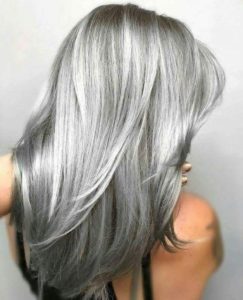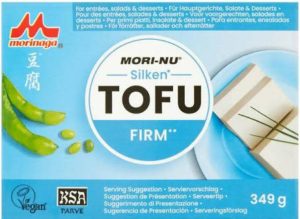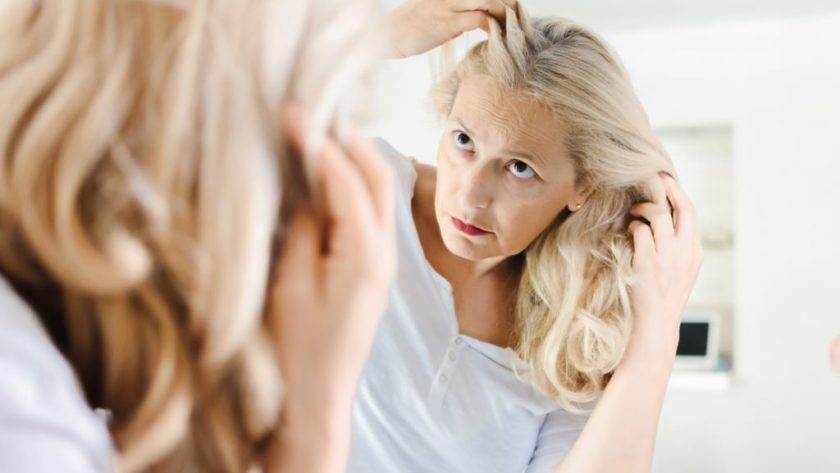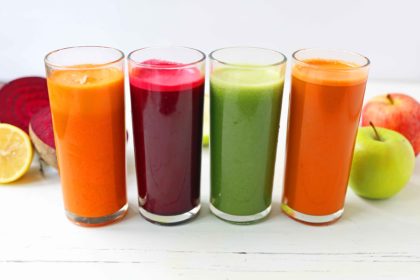Hair is initially white (no pigment) and gets its natural color from a type of pigment called melanin.
Melanin begins forming (melanogenesis) in utero and is produced by specialized pigment cells called melanocytes. These cells are located at the opening of the skin’s surface where the hair grows.
When a hair is being formed, melanocytes inject pigment into epithelial cells within the hair follicle (a sac from which the hair grows).
Blonde, Brunette and Somewhere In-Between
Hair has only two types of pigments – dark (eumelanin) and light (phaeomelanin) – but they create a wide range of colors. Your natural hair color is determined by the amount of and blending of melanin in the middle layer of the hair shaft (cortex).
Gray Hair

White hair has no pigment. Gray hair has a reduced amount of pigment. The mixture of pigmented hair and white hair produces the perception of “gray hair”.
Hair loses color and starts to gray when pigment cells (melanocytes and melanocyte stem cells) age and disappear and levels of enzymes decrease. The chances of your hair color turning gray increase 10-20% every decade after your 30th birthday.
Free Radicals Age Pigment Cells
The aging of melanocytes may be associated with highly reactive free oxygen radicals that damage DNA in the nucleus and mitochondria. The originator of this oxidation process is hydrogen peroxide, a byproduct of oxygen metabolism (energy production). As a result:
- Mutations accumulate with age
- Antioxidant mechanisms no longer regulate properly
- Factors that affect cell death within the cells no longer regulate properly
Natural Hair Bleach

According to Dr. Gerald Weissmann, a research professor of medicine at New York University and editor-in-chief of The FASEB Journal:
- Hydrogen peroxide (H2O2) – a known bleaching agent – is produced in all parts of the body, including the hair follicles.
- As you age, the levels of the enzyme “catalase” begin to decrease. Catalase decomposes hydrogen peroxide to water and oxygen. With the near absence of catalase, hydrogen peroxide accumulates and cannot break down.
- Hydrogen peroxide also attacks the enzyme tyrosinase and ultimately, inhibits the production of melanin. Tyrosinase is the key enzyme required for melanocytes to produce pigment.
- This “natural bleach” accumulates in the hair and other enzymes diminish within the melanocytes which would ordinarily repair hydrogen peroxide’s damage. As a result, the hair loses pigment and turns gray.
 A study shows a link between the consumption of soy isoflavones (in particular daidzein and genistein) and the increased activity of the antioxidant enzyme catalase.
A study shows a link between the consumption of soy isoflavones (in particular daidzein and genistein) and the increased activity of the antioxidant enzyme catalase.
This study was undertaken to test the effect of soy on the expression of catalase since Asian populations that traditionally consume soy-based food show a reduced incidence of cancer.
See Can Enzyme Supplements Prevent Gray Hair
The Life Cycle of a Hair

Dr. Desmond Tobin, professor of cell biology from the University of Bradford in England, has studied melanocyte activity.
According to Dr. Tobin, the hair growth cycle and hair pigmentation systems are closely associated. The melanocytes seem to have a “biological clock” whereby the potential for these cells to produce pigment is limited.
After the first 10 cycles or so, an individual hair loses color and becomes gray or white just as it is preparing to fall out.
This color change suggests the potential for melanocytes to produce pigment becomes exhausted due to genetics and age.
The rate at which your hair turns gray varies between people and may occur slowly over many decades or rapidly in life.
The Benefit of Hair Color
Melanin may selectively bind to heavy metals, chemicals, and toxins and therefore, assist in the rapid excretion of these unhealthy substances. Due to what seems to be a possible benefit of hair color, controlling the factors that cause melanocytes to age and die can positively affect your health.
Factors that Turn Hair Gray
Scientists have associated intrinsic (physiologic) and extrinsic (environmental) factors that can change or cause the absence of pigment in the hair.
Intrinsic factors:
- Genetic defects (i.e. albinism)
- Hormones (i.e. thyroid deficiency)
- Age
- Medical conditions (i.e. Werner syndrome and pernicious anemia)
Extrinsic factors:
- Tobacco (a 1996 British Medical Journal study conducted by J.G. Mosley, MD found smokers four times more likely to begin graying prematurely compared to non-smokers)
- Ultraviolet radiation
- Pollutants
- Toxins
- Chemical exposure
- Vitamins (i.e. B12 deficiency)
- Nutrition
- Malnutrition (color and texture changes are reversible with proper nutrition)
Reversing Gray Hair
Advances in scientific research and the ability to grow hair follicle melanocytes in vitro raised the possibility of reversing the loss of pigment in the hair.
It is not too uncommon to see spontaneous repigmentation along the same individual hair shaft when hair starts to turn gray. Moreover, white and gray hair follicles have regained color in vitro.
French scientists, led by Gabriel Etienne of the Universite Victor Segalen in Bordeaux, treated leukemia patients with a new cancer drug, Gleevec, and noted an unexpected side effect: 9 of 133 patients’ hair color was restored to their pre-gray color.
![]() Karen’s Fit Tip: Slow the graying process with good hair care, which includes following a healthy lifestyle and nutritious diet.
Karen’s Fit Tip: Slow the graying process with good hair care, which includes following a healthy lifestyle and nutritious diet.
- Include soy-based foods to induce catalase activity and break down hydrogen peroxide (hair’s natural bleach).
- Eat a diet rich in antioxidants to battle the oxygen radicals, or “free radicals”, that cause hair pigment cells to age and stop producing hair color.
- Avoid preservatives (e.g. benzoates) that damage vital mitochondria and cause an increase in circulating oxygen radicals.
- Pay attention to the extrinsic factors mentioned above that cause hair to turn gray.





